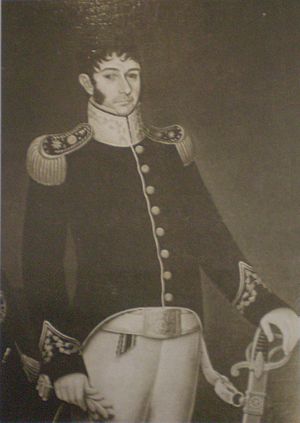Nicolás Rodríguez Peña facts for kids
Quick facts for kids
Nicolás Rodríguez Peña
|
|
|---|---|

Peña, oil by J. Gil de Castro. Museo Histórico Nacional
|
|
| Member of the Second Triumvirate | |
| In office 8 October 1812 – 31 January 1814 Serving with Juan José Paso, Antonio A. Jonte
|
|
| Preceded by | First Triumvirate |
| Succeeded by | Office abolished |
| Personal details | |
| Born | 30 April 1775 Buenos Aires, Viceroyalty of Peru |
| Died | 3 December 1853 (aged 78) Santiago, Chile |
| Spouse | Casilda Igarzabal |
| Signature |  |
Nicolás Rodríguez Peña (born in Buenos Aires in 1775 – died in Santiago de Chile in 1853) was an important Argentine politician. He was born in April 1775 in Buenos Aires. He became very wealthy through his work in business.
Among his many successful businesses, he owned a soap factory with Hipólito Vieytes. This factory became a secret meeting place for people who wanted to start a revolution against Spanish rule. In 1805, he joined a secret group called the "Independence Lodge." Other famous leaders like Juan José Castelli and Manuel Belgrano were also part of this group. They often met at his ranch, which is now a square in Buenos Aires called Rodríguez Peña.
Contents
Fighting for Independence
Early Actions Against Spanish Rule
Nicolás Rodríguez Peña was a member of the local militia during the British invasions of the Río de la Plata in 1806 and 1807. These were attempts by the British to take over parts of South America.
He also helped start and pay for the May Revolution. This revolution led to the creation of the Primera Junta, which was the first independent government in Argentina. He worked as a secretary for Castelli and traveled with him on a military trip to Córdoba. There, he approved the removal of the previous Spanish leader, Santiago de Liniers.
Military Service and Governing Roles
After fighting in the Battle of Suipacha, he went to Upper Peru (which is now Bolivia). For a short time, he was the governor of La Paz.
He returned to Buenos Aires in February of that year. He took the place of Mariano Moreno in the First Junta. However, a revolution in April 1811 led to his removal from power. He was sent away to San Juan Province.
Return to Politics
Joining New Revolutionary Groups
Later in 1811, Rodríguez Peña came back to Buenos Aires and started working in business again. He then joined another important secret group called the Logia Lautaro. This group was led by Carlos María de Alvear.
Because of a revolution in October 1812, he was chosen to be a member of the Second Triumvirate. This was a new government created by the Constitutional Congress. A triumvirate is a government led by three people.
Important Government Positions
When the Triumvirate ended, the new leader, Gervasio Antonio de Posadas, chose Rodríguez Peña to lead the State Council. This was an important advisory group for the government. He was also made a colonel in the army. In 1814, he became the first temporary governor of the Banda Oriental (which is now Uruguay). He held this job for only a short time.
Exile and Later Life
Helping San Martín's Army
After another leader, Alvear, lost power, Rodríguez Peña was accused of wrongdoing. He was judged and sent away from Buenos Aires. He was allowed to live in San Juan. In 1816, he tried to return to Buenos Aires. But the new leader, Juan Martín de Pueyrredón, forced him to go back to San Juan.
While in San Juan, he helped José de San Martín organize the Army of the Andes. This army was very important for crossing into Chile to fight for independence there.
Final Years in Chile
After the Battle of Chacabuco in Chile, Nicolás Rodríguez Peña decided to live in Santiago de Chile. He stayed there until he passed away in December 1853. His body was later brought back to Buenos Aires and buried in La Recoleta Cemetery.
See also
 In Spanish: Nicolás Rodríguez Peña para niños
In Spanish: Nicolás Rodríguez Peña para niños

